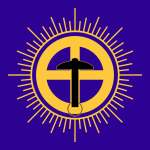Wheel cross

The wheel cross , also sun cross or sun wheel ( Danish Hjulkors ), is a motif of iconography of the Nordic prehistoric times. It is a circular wheel, the spokes of which form a cross that divides the circle into four equal areas. The motif appears as petroglyphs , such as the rock carvings by Allinge-Sandvig , and on ceiling stones from large stone graves ( Bunsoh , Mechelsdorf 2 ), but mostly on Bronze Age finds. On the one hand, the wheel cross is an image of the sun or the solar disk , on the other hand, according to the Danish archaeologist Flemming Kaul, it can be interpreted as a symbol for the day-night cycle and the cycle of the seasons . In Egyptian depictions, "four-spoke wheels" resembling the wheel cross appear on chariots. This form is technically not drivable and is therefore only symbolic. In the Middle Ages it was used as a consecration cross on church buildings.
The wheel cross in Europe during the Bronze Age

The representation can be found in many Bronze Age cult objects, such as B. the sun chariot from Trundholm or ornate bronze razors , z. B. in the form of the sun ship .
Wheel crosses are particularly found in rock carvings and stone decorations, e.g. B. on Bornholm or Greby . They also appear as the middle part of anthropomorphic representations. After bowls and ships, wheel symbols are the largest group of images in rock carvings in Scandinavia. Petroglyphs with four, less often eight spokes are found in Denmark and Sweden .
In rock carvings, wheel crosses are often shown on plinths ( sun steles ). Since rock paintings are believed to be realistic depictions of rituals, it can be assumed that real wheel crosses were used in the ceremonies. Such are proven by finds, e.g. B. by a miniature sun picture on a stand ( Danish National Museum ) and a stone in the shape of a wheel cross with four bowl pits , which was found in 1999 on Zealand .
Wheel crosses in Germany
A wheel cross is on the capstone of the large stone grave of Bunsoh in Schleswig-Holstein . Boulders with corresponding representations are also found in Mecklenburg-Western Pomerania at megalithic sites in the region around Rerik . A sandstone weighing around 60 kg (0.54 × 0.49 × 0.26 m) was discovered by a fossil collector around 1988 on the Baltic Sea beach near Börgerende-Rethwisch (Rostock district) in a pile of reading stones. The stone came to the Rerik Museum in 2013.
Symbolic meaning
In the free interpretation of the wheel cross as a representation of the cyclical course of the sun's movement in day-night rhythm, the horizontal cross strut represents the earth as a disk . The upper semicircle shows the path of the sun during the day, from the morning sunrise (left intersection) over the noon until evening sunset (right intersection). The lower semicircle represents the path of the sun through the underworld at night . When applied to the cycle of the seasons, sunrise is to be equated with spring , midday with summer , sunset with autumn and midnight with winter .
Newer use as a symbol
In the present, the wheel cross is still used as a symbol, e.g. B. in neo-paganism , esotericism and occultism , but also in groups with racist and neo-Nazi ideology.
Religious symbol

Like the swastika , the wheel cross is used as a sun cross by neo-pagan groups and organizations to represent the sun and the cycle of the year. In the Wicca religion, for example, there is a wheel of the year with four solar festivals. Fire wheels , ie wheel crosses made of straw, are used in various fire customs .
The neo-pagan association Germanic Faith Community uses a Thorhammer in front of a golden wheel cross on a blue background as a symbol .
In Christianity it is found as a consecration or apostle cross in various churches. Obsolete, it is also known as the papal cross , as it served as a papal emblem until the Reformation. Today's papal cross , however, has a different shape. In the Memleben monastery (where Emperor Otto the Great died) you can find a wheel cross in the wall of the east wing of the enclosure.
Political symbol

The European federalist Paneuropean Union uses a red wheel cross (symbol for humanity) with a yellow background (symbol for enlightenment ) in a blue flag. After the founding of the Council of Europe and the European Union , a circle of twelve stars was added.

The Norwegian fascist party Nasjonal Samling , which existed from 1933 to 1945, used a golden sun cross on a red background as an emblem .
The Swedish neo-Nazi party Nordiska rikspartiet , which existed from 1956 to 2009, used the black wheel cross on a red flag.
Scientific symbol
In mathematics, ⊕ (circled plus sign , Unicode : U + 2295 circled plus sign ) is the link symbol for the vectorial direct sum as well as an occasionally used link symbol for the logical contravalence .
In the Alchemy which is the circled plus sign similar ? the symbol for verdigris ( "AES viride" , Unicode: U + 1F728 alchemistical symbol for verdigris in block Alchemistical symbols ).
In astronomy and astrology , the ? (U + 1F728) is also one of the two symbols for the earth. The cross axes stand for the equator and the prime meridian , astrologically it also symbolizes the point of happiness in the horoscope drawing ( Pars Fortuna ). Of the two earth symbols, this is used more frequently in astronomy, the other ( ♁ , Unicode: U + 2641 earth ) predominantly in astrology.
Other uses
In the English Dartmoor there in stone hewn wheel crosses, as boundary markers ( boundary marks apply).
The earth symbol ⊕ is also used as a gender symbol for intersexuality . This is not without reason, because "intersexual" means between the sexes . The genders are represented by the Mars ♂ (man) and Venus ymbol (woman) symbols, and the earth lies between Mars and Venus. More often, however, a combination of the Martian and Venus symbols is used.
In the North African Tifinagh script , the letter ⴲ (Unicode: U + 2D32 tifinagh letter yabh ; French transcription: rt ) occurs with this form.
In the Bronze Age linear font B , the syllable ? (Unicode: U + 1000F linear B syllable B077 ka ) and the ideogram ? (Unicode: U + 100CF linear B ideogram B243 wheel ) occur with this form.
See also
literature
- Flemming Kaul: The Myth of the Sun's Journey. Representations on bronze objects from the late Bronze Age. In: Gold and Cult of the Bronze Age. (Exhibition catalog) Germanisches Nationalmuseum, Nuremberg 2003, ISBN 3-926982-95-0 .
- Peter Vilhelm Glob : Helleristninger i Danmark (= Jysk Arkæologisk Selskabs skrifter. Volume 7). Jysk Arkæologisk Selskab, Højbjerg 1969, ISSN 0107-2854 .
Web links
Individual evidence
- ↑ a b c Flemming Kaul: The myth of the sun's journey. Representations on bronze objects from the late Bronze Age. In: Gold and Cult of the Bronze Age. (Exhibition catalog). Germanisches Nationalmuseum, Nuremberg 2003, pp. 41–45.
- ↑ Flemming Kaul: The myth of the sun's journey. Representations on bronze objects from the late Bronze Age. In: Gold and Cult of the Bronze Age. (Exhibition catalog). Germanisches Nationalmuseum, Nuremberg 2003, pp. 17–44.
- ↑ Dr. C. Michael Schirren (August 1, 2013): Holy Signs ... A newly discovered stone with a wheel cross ( Memento of the original from February 1, 2014 in the Internet Archive ) Info: The archive link was inserted automatically and has not yet been checked. Please check the original and archive link according to the instructions and then remove this notice. . In: Landesarchäologie Schleswig-Holstein.
- ↑ Pan-European Manifesto. (PDF; 359 kB), p. 7.
- ↑ Dave Brewer: Boundary markers. Halsgrove 2002, pp. 249-251.




